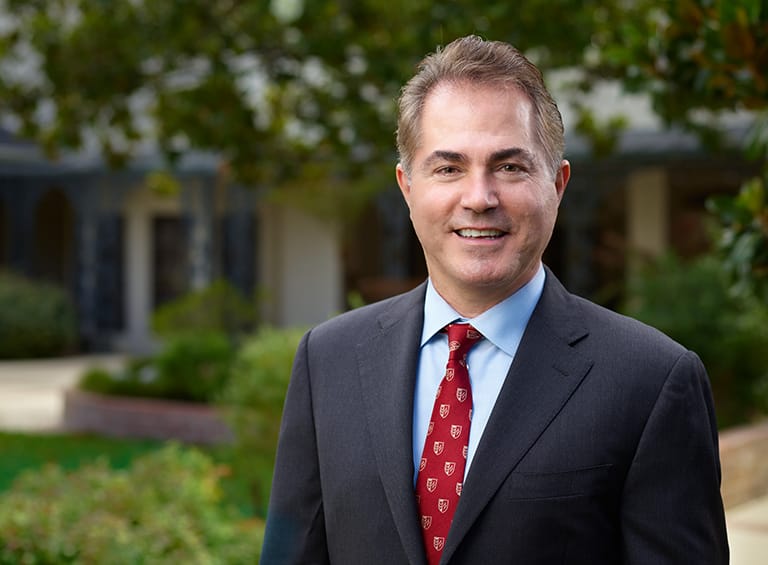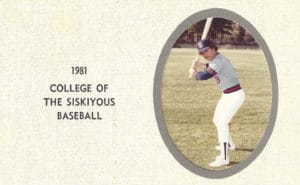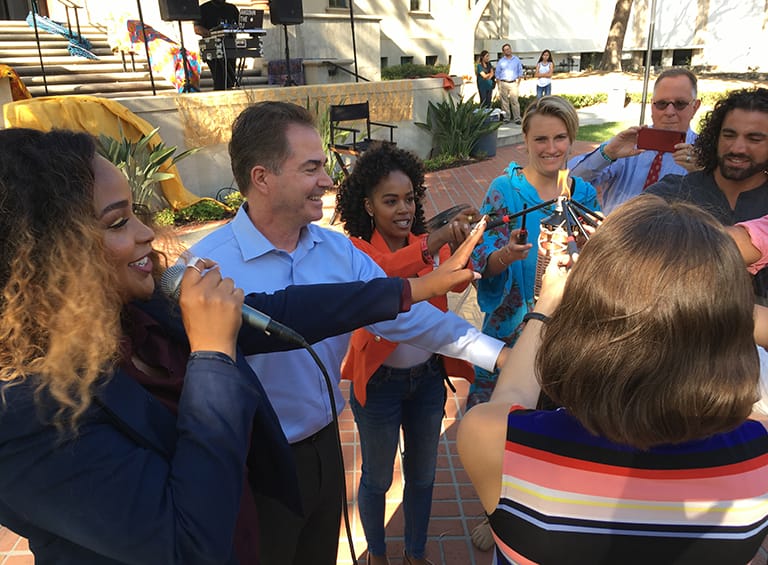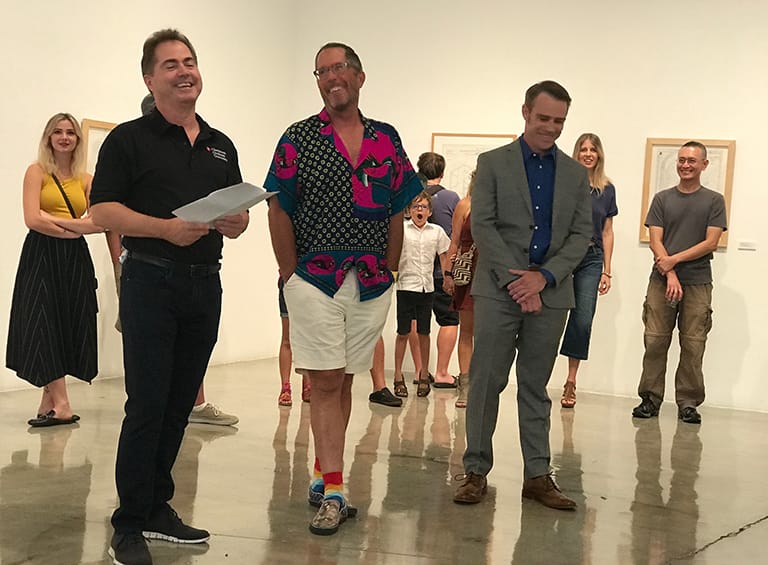Major League: Len Jessup Steps up to the Plate as CGU’s 12th President

One of the early influences on Len Jessup’s career was a fellow baseball player.
As a teenager, Jessup played baseball at the College of the Siskiyous, a community college not far from the California-Oregon border.
Though playing centerfield wasn’t his first choice—he says he was really built to play second base—the coaches wanted him there because of his speed. Jessup worked the outfield the way a good pool player works the table.
Growing up in Northern California, Jessup, the son of a working-class Italian family, dreamed of going all the way—or at least to a good farm team connected with the majors.
Until he faced one of Siskiyous’s best pitchers at practice.
The pitcher was a big guy with a fastball in the high 80s who could throw changeups, curveballs—you name it—and each teammate faced him in order to test himself, to see if he could hit against good pitchers that they would see at the next level.

“He threw hard, and I knew in two minutes at the plate that a baseball career wasn’t in my future,” Jessup says. “It might seem hard to believe, but I was actually okay with that. I eventually stopped worrying about trying to make a career out of it and just enjoyed playing baseball. In the end it turned out to be a real blessing for me.”
Jessup never gave up his passion for baseball (ask him about his impressive memorabilia collection and you’ll see for yourself), but he discovered another passion instead—for teaching and leadership—and followed it into higher education’s major leagues.
This past spring Jessup left the presidency of the University of Nevada, Las Vegas (UNLV), to become the 12th president of Claremont Graduate University (CGU).
With his partner Kristi Staab, Jessup, 57, settled into the President’s House on Harvard Avenue and started a “listening tour” this summer to get to know the community. The President’s House and Harper Hall haven’t seen a flurry of activity like this in years. He also spent the summer exploring the Claremont Village with his son and daughter, who divide their time between him and their mother, a professor at Washington State University.

Today Jessup is connecting with movers and shakers in the region (and beyond) to gauge their interest in partnerships and other possibilities at CGU. Sometimes he turns to old baseball expressions to describe his work as president.
“You’re always looking for ways to make things happen, to stretch a base hit into something more. You’re looking for opportunities,” he says, “and I see many for our school. This is a great time for us.”
Before the start of the 2018-2019 academic year, The Flame sat down with President Len Jessup to learn more about his upbringing, his past experiences, and his vision of CGU’s future.
Up Close and Personal
How do you and Kristi like Claremont life? This isn’t your first experience of living in a small town, right?
We love it. It’s a great walking town, and we love the fact that we can walk down to the village and over to campus. We’ve lived in some great college towns over the years, and we know what that life is like, and I have to say that this is the best college town experience we’ve had. CGU is in the ideal location—you have the mountains, deserts, and the ocean nearby, and the L.A. basin is your playground. Location means everything, and CGU has it.
So, how does someone who is 100-percent Italian end up with a very un-Italian sounding last name?
(laughs) I come from a long line of Italian small-businessmen and -women on both sides of my family. Both sets of grandparents immigrated through Ellis Island into New York and then to San Francisco where my parents were born and that was where I was born and grew up. My understanding from my relatives is that some clever agent at Ellis Island changed our name to something that would be easier to pronounce. My dad’s side of the family was from Venice, and they were the Gisottos—but somehow it was changed to “Jessup.” I guess because it’s a classic Mayflower name. There’s a town in Maryland called Jessup.
Your connection with CGU goes back further than most people realize. When you were a management information systems graduate student at the University of Arizona in the 1980s, how did you learn about this university?
I used to go to information systems conferences and I’d see Paul Gray there and talk with him about what was happening at the graduate school. He was an amazing pioneer of information systems, and he always had so many interesting things to talk about. He founded what is known today as our Center for Information Systems & Technology (CISAT), and I knew CISAT Director Lorne Olfman, too, who was a contemporary of mine. I was quite familiar with the university’s program and faculty, and that connection meant a lot to me when I had the chance to become CGU’s president.
The other day, when we were touring campus, we walked through the Academic Computing Building and I saw something in the lobby that I’d heard about for a long time: The Paul Gray Personal Computer Museum. That was pretty emotional for me; I started thinking about him again and our connection a long time ago, and the fact that I’m here now. It made me grateful for the way things work out in life.

UNLV is a massive school. There are 30,000 students, about 4,500 employees, a medical school, major athletic teams, and an annual budget of approximately $700 million. What’s the difference between being the leader of a large school and a smaller one like CGU?
At really big universities you feel like you’re trying to turn a battleship or a battleship group just to make a change. It’s not that way at CGU. We’re small, nimble, entrepreneurial, very creative, and very externally facing. That’s a big advantage at a time when many universities are struggling to change and adapt to the needs of the marketplace.
That’s not to say I’m not glad about my experiences at UNLV. I had a chance to run a big shop, and it was a great opportunity to stretch myself and learn a lot. But CGU is not like UNLV. With 2,200 students and 22,000 alumni, I think we’re better off than a massive university with 100,000 alumni who get lost in the shuffle. That’s not going to happen here. We’re all part of one tight, integrated team, and we’re all working together to take CGU to the next level.
UNLV may be too large to compare to CGU, but the Eller College of Management at the University of Arizona isn’t. When you joined Eller as the dean, it was a small shop just like CGU, right?
Definitely. What I did at Eller is probably the closest analogue to what I’m doing now. It is small, very high quality, and really tough to get into. I was recruited from Washington State University (WSU) to go back there and help to privatize the business school. It was a challenge to take the business school of a public university and turn it into more of a self-sustaining entity, but we did it. And I find that I’m drawing on my lessons and experiences there as I’m thinking about strategies for CGU.
The media describes you as a highly effective fundraiser. Your list of achievements is long. You helped double Washington State University’s annual fundraising from $45 million to $90 million, led Eller’s rise in national rankings for its graduate and undergraduate programs, and had a string of major successes at UNLV in just a few short years. What achievements are you most proud of?
As I look back, honestly, it’s not necessarily the things you might expect. Yes, we launched a medical school at UNLV and built a stadium to attract the Raiders football team. We hosted the last 2016 U.S. presidential debate, too. At Arizona, we privatized Eller and helped to design and launch a great career-services facility and staff; at WSU we broke fundraising records. Those things are definitely on my list, but when I look back on my proudest accomplishments, there are some smaller, private things on it.
I’m really proud that Kristi and I funded a scholarship for one of the inaugural students at the UNLV medical school. Another thing we did at UNLV was extend to the classified staff the same benefit that faculty and professional staff get so that their kids can attend the university at a discount rate. For some of those classified-staff families, the impact of a discounted education was a major, life-changing opportunity. Those are the kinds of things that, when I get to the end of my path one day, I’m going to look back on and feel like I did something good.
If you had to summarize your experience as UNLV president, what would you say?
While I was there we talked about UNLV being in a renaissance period. It really was. As the city was growing, the university was growing and preparing to become a Carnegie R1 institution. It was a really magical time. There were so many new ideas and viewpoints taking place, so many people working together. It didn’t have anything to do with me. I was just lucky enough to be there when everything was happening.
By the time you arrived at UNLV, you were already a seasoned veteran, but did your experience there teach you anything?
I definitely learned a lot. I feel like I’m still learning. By the time, I left I felt like we’d accomplished a lot, and I took it as far as we could go within that governance structure. That was a lesson to me. I realized how important governance is—that it can be an amplifying factor or a limiting factor. You’re always trying to draw on your experiences and lessons so that you’ll do a better job with your next challenge.

When you look at CGU, do you see similar possibilities for growth and a renaissance?
I do. The themes of leadership, innovation, health and well-being, creative practice, and serving vulnerable populations are so strong here. I see them all over our campus, in so many programs. When I think of all the potential partnerships that can grow from this, I’m excited. As we build up our student enrollment levels, I’m also looking at some other interesting opportunities on the horizon, like the purchase of The Huntley Bookstore, which would give us a chance to fill out our campus footprint with a great piece of real estate right in the middle of everything. We’re exploring that and some other options right now.
When I look ahead, I want our university to keep pursuing excellence. We want to be the best in class in whatever we do. I also envision that we are going to become more tightly connected and integrated with our alumni. We’ll be coming to see them soon; I want CGU to help them connect with each other on their professional journeys and bring them back to campus for signature events. I envision a much more externally-focused and tightly-connected CGU family. I want us to embrace the idea of service to each other. That’s an important value for me that I learned from my own family. It has pretty much defined everything in my life.
How has it defined everything for you?
Part of the reason why I devoted myself to higher education in the first place—when I realized a baseball career wasn’t in the future—was to pay back my ancestors and everyone before me who left the oppression of Italy in the late 1800s. They came here to find a better life for the grandchildren they didn’t even have yet. They were making a sacrifice for me before I was even born. Part of what I’m doing in my career is paying back a debt to them for their sacrifices. I also want to give something back to higher education because it has given me so much in my life.